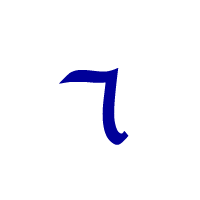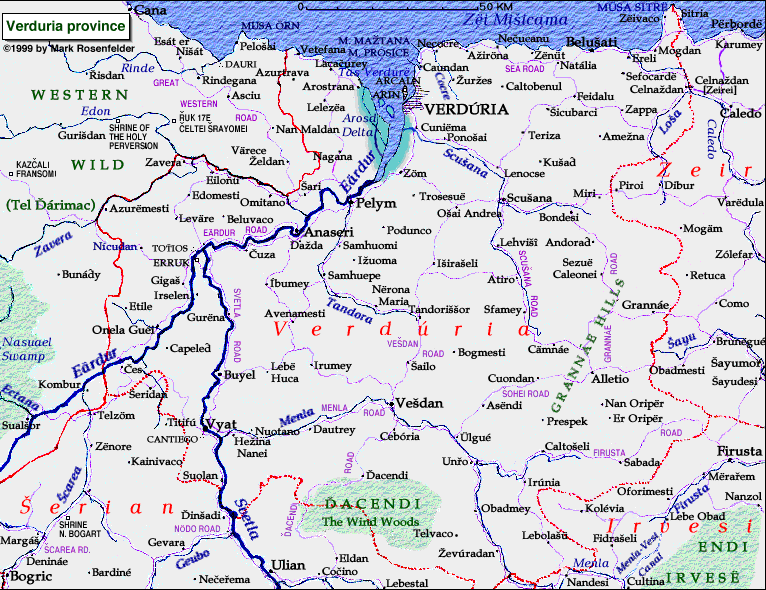The 2020 Smiley Award Winner: Verdurian
The 2020 Smiley Award is presented to Verdurian, a massive artlang created by Mark Rosenfelder. Congratulations, Mark!

https://www.zompist.com/verdurian.htm
Dungeon Delver
Mark Rosenfelder is one of the lucky few who have been conlanging as long as they can remember. He had been happily creating worlds and languages for many years, but things began to take a more serious turn when he got to college. As a freshman at Northwestern University, Mark happened to live next door to a Dungeons & Dragons dungeon master named Chris Vargas. Chris was working on a dungeon, and Mark decided to help flesh out the game world, creating a map of the surrounding wilderness and supplying Chris with unique in-world terms for flavor.
This will sound familiar to those of us who have done role playing in one form or another. However, some maps are more impressive than others. Take a look at this map of the surrounding area which came to be known as Verduria:
Perhaps this should have been a clue as to what was in store. As the D&D group continued on throughout college (an impressive achievement in and of itself!), Mark continued to work on the Verdurian language, as well as some of the other languages of the world. By the end of college he had amassed quite a bit of documentation and artifacts related to Verdurian and the D&D world their party had inhabited. And once the group was no more, what was there to do with all that stuff, other than...keep building on top of it for the next 36 years?
Early Verdurian
Like many long-lived conlangs, Verdurian has undergone significant and extensive revisions from its earliest stages. At the outset, Mark grabbed words from various natural languages (especially Russian and French) and imported them directly, or with minor modifications. This ad hoc approach to vocabulary creation is common in early conlangs, but it's also common in D&D campaign creation. Some early vocabulary is shown below:
- druk "friend" (cf. Russian друг [dɾuk])
- dormir "sleep" (cf. Spanish dormir)
- filio "son" (cf. Latin fīlius)
- amor "love" (cf. Spanish amor)
- dobre "good" (cf. Russian добро [dɔbɾə])
- brak "arm" (cf. Latin brachium [brakium])
Some of these words (e.g. filio) were ultimately replaced, but a lot of them remain, which you can see by scrolling through the Verdurian dictionary. Mark also attempted to work backwards with Verdurian, filling in plausible etymologies for incidental similarities between Verdurian and natural languages. For example, dobre remains in the language. For its etymology, Mark posited that the word came from older *domeres, which meant "fine" or "handsome" at some point in the past. And that's plausible enough! You have an unstressed vowel getting lost (*domeres > *domres), the nasal changing to a stop in front of the *r (*domres > *dobres), and then finally the *s being lost, perhaps with an inital stopover at *h (*dobres > *dobre).
I've mentioned previously that working backwards to a proto-language from a modern language is much harder than the reverse, but Mark has said as much himself. Nevertheless, he pressed on and tried his best to make Verdurian a language derived at least somewhat systematically from its proto-language Cadhinor. In many ways, he was quite successful, as there are some unique historical quirks in Verdurian that wouldn't have been there otherwise (and I'll touch on a few of those later!).
Current Verdurian
In many ways, the family that came to surround Verdurian is even more impressive than Verdurian itself, but the language is not without its charm. Verdurian is an SVO, lightly-inflectional, head-initial language. It has two genders (masculine and feminine), four cases (nominative, accusative, dative, and genitive), and four tenses to go along with a conditional and an imperative series. In many ways, it looks like what has come to be known as a Euroclone, but I want you to remember that the grammar of Verdurian, as it is, was in a mostly completed state in 1984. That's seven years before the Conlang-L was founded. It's no wonder we saw so many Euroclones in the early days, and why they keep coming back: They were likely inspired, in whole or in part, by Verdurian.
When designing a romanization system, one often has to decide between a phonetic system and a system that more accurately reflects the phonology or history of the language, provided that phonology or history is useful for understanding how the current language works. Verdurian takes a wholistic approach to its romanization system. Consequently, some of the romanization choices are standard (r for [ɾ], ö for [ø], ü for [y], and y for [j]), some are quite common (č for [tʃ], š for [ʃ], ž for [ʒ], ď for [ð], and ř for [ʁ]), some are quirky (c for [k] and k for [q]), and some reflect deeper patterns in the history of the language. For example, y is also used for word-final [i] to distinguish masculine from feminine nouns (so there are other nouns that end in i as expected). There are also pieces of the system that reflect the actual orthography of Verdurian. For example, the roman characters that have umlauts have very similar markings in the Verdurian script, as shown below:
| Letter Style | A/Ä | E/Ë | O/Ö | U/Ü |
| Unumlauted |  |
 |
 |
 |
| Umlauted |  |
 |
 |
 |
Turning to the language itself, there's no way to hit all the highlights of the grammar of Verdurian (if you want a quick summary, go here, and if you'd like the full rundown, go here), but I do want to hit on a few things I found that piqued my interest—starting with noun declension. This is how the various types of masculine nouns decline:
| Verdurian Masculine Nouns | ||||||||||
| Case | craď "carp" | fako "box" | altu "tyrant" | peny "comb" | pica "scorpion" | |||||
| Singular | Plural | Singular | Plural | Singular | Plural | Singular | Plural | Singular | Plural | |
| Nominative | craď | craďî | fako | fakoi | altu | altî | peny | penî | pica | picai |
| Accusative | craď | craďi | fakam | fakom | altum | altom | penim | penom | pica | picam |
| Dative | craďán | craďin | fakon | fakoin | altun | altuin | penín | penuin | pican | picain |
| Genitive | craďei | craďië | fakei | fakoë | altui | altuë | penii | penuë | picei | picaë |
And here are the feminine declensions:
| Verdurian Feminine Nouns | ||||||||||
| Case | žuca "role" | sosia "whisper" | cäli "stalk" | güsce "jungle" | lanë "linen" | |||||
| Singular | Plural | Singular | Plural | Singular | Plural | Singular | Plural | Singular | Plural | |
| Nominative | žuca | žucî | sosia | sosiî | cäli | cälî | güsce | güscî | lanë | lanî |
| Accusative | žuca | žucem | sosiam | sosem | cäla | cälem | güsca | güscem | lanä | lanem |
| Dative | žucan | žucen | sosian | sosen | cälin | cälin | güscen | güscen | lanë | lanî |
| Genitive | žuce | žucië | sosë | sosië | cälë | cälië | güscei | güscië | lanëi | lanië |
Let me note something here about the romanization and phonology that I find fascinating. The character î stands for [ɪ], a high front lax vowel that is best described as a marginal phoneme. The sound [ɪ] is purely allophonic except in inflectional paradigms, where it plays an important role, as you can see above. The story behind it is that Vedurian laxes /i/, /u/, and /o/ before a word-final consonant to [ɪ], [ʊ], and [ɔ], respectively. The old plural of Verdurian used to be *-it. This is precisely the position where /i/ would have laxed to [ɪ], and indeed it did. Later the final *t was lost, leaving the [ɪ] behind. Were it a new word, the final vowel would be pronounced [i], rendering the nominative singular and plural forms of a word like cäli identical. By retaining the final [ɪ], the forms remained distinct, and a phonemic distinction was created where none existed prior.
The phenomenon I just described happens all the time in natural languages, but it's ridiculously hard to replicate in a conlang. This was a stroke of genius! It's precisely this type of detail that I look for in a naturalistic conlang, and one of the many things that makes Verdurian truly impressive.
Verdurian Complexities
There's more than that in the massive Verdurian grammar over at Zompist.com. In this section I'll list some of my favorite bits—things that surprised and intrigued me.
Verdurian has a fully conjugated imperative (i.e. an imperative form which agrees with its subject in number and person, just as other Verdurian verb forms do), which is unusual, though not impossible. Generally with persons other than the second, imperatives have some interpretation other than a command, in the strict sense, and Verdurian is no different. Specifically, non-second person imperatives in Verdurian are better classified as hortatives, so parallel with something like "Let me think", or "Let him stay" in English. Here's an example of those forms:
| Verdurian Imperative | ||||||||||
| Person | cramen "to grill" | yanir "to admire" | felec "to sail" | |||||||
| Singular | Plural | Singular | Plural | Singular | Plural | |||||
| First Person | cramenai | cramenam | yaniru | yanirum | felecao | felecom | ||||
| Second Person | cramenei | crameno | yanireu | yaniro | feleceo | feleco | ||||
| Third Person | cramene | cramenu | yanire | yanirü | felece | felecu | ||||
These forms are built by combining the regular personal endings with the infinitive form of the verb. Now one might wonder where these came from, since it is a bit unusual to have a full series like this for an imperative. In the grammar, Mark points out that the imperative looks a lot like the past tense, and he's right:
| Verdurian Past Tense | ||||||||||
| Person | cramen "to grill" | yanir "to admire" | felec "to sail" | |||||||
| Singular | Plural | Singular | Plural | Singular | Plural | |||||
| First Person | cramnai | cramnam | yanru | yanrum | felcao | felcom | ||||
| Second Person | cramnei | cramno | yanreu | yanro | felceo | felco | ||||
| Third Person | cramne | cramnu | yanre | yanrü | felce | felcu | ||||
Essentially, the past tense is a reduced form of the imperative, where the imperative retains a vowel the past tense jettisons. Peculiar, to say the least! For the curious, though, Mark offers this insight:
The imperative looks a lot like the past tense, and historically that’s what it is. (Compare French si nous allions? ‘shall we go?’— literally a past imperfect.)
And wouldn't you know it, that is what that is! In fact, the French might be more literally translated as, "If we were going?" And as an English speaker, I can see how that might be an ultra tactful way of making a suggestion. That is, rather than coming out directly and saying, "Go!", if one were to inquire as to whether or not that thing might have already been occurring, what's the harm in that?
And this, then, is followed up by the revelation that Verdurian has a second imperative form, shown below:
| Verdurian Classical Imperative | ||||||||||
| Person | cramen "to grill" | yanir "to admire" | felec "to sail" | |||||||
| Singular | Plural | Singular | Plural | Singular | Plural | |||||
| Second Person | crami | cramil | yanu | yanul | fele | felel | ||||
On the use of this imperative, Mark says the following:
These forms have come to be seen as extremely rude; they are only used for servants or enemies, and often not even then.
And now, of course, it falls into place. The classical imperative was the original imperative, and, like ordinary imperatives, worked only with a second person subject in a very traditional way. As it came to be seen as too forceful or aggressive, the secondary imperative developed from a less aggressive expression, and eventually that form itself crystallized—preserving a vowel that had been lost in the past tense along the way. This is precisely the type of evolution one sees in a natural language, and it's truly inspiring to see something similar in a conlang. It's a hallmark of great skill.
Something else impressive about Verdurian and its grammar is the attention Mark has paid to explicating its syntax. It's rare to see it written up this way, and it's both helpful, in seeing how the language works, and a great demonstration of what makes Verdurian special. As syntax is often a bit opaque (the jargon linguists used to discuss it is problematic, for a variety of reasons), many conlangers will leave aspects of the syntax of their conlang unspecified. In some ways, that's fine (a conlanger doesn't need to be a great grammar writer), but it's unfortunate when the conlanger simply assumes that all languages work like their first language (often English). It's useful to demonstrate how one's conlang differs from one's first natlang in ways that go beyond word order, and there are a couple wonderful examples in Verdurian.
In English, our arguments can move around a bit between the subordinate and matrix levels. This means that while it's fine to say the following:
- It's easy to please John.
You can also say this and no one will bat an eye:
- John is easy to please.
And while that may look ordinary to an English speaker, it is kind of weird, isn't it? In sentence (1), "John" is the object of "to please". In sentence (2), however, while "John" is certainly the semantic object of "to please", "John" is actually the syntactic subject of "is" (consider that you have to say "I am easy to please", not "*I is easy to please"). Despite the oddity, this is no problem in English.
It turns out you can't do the same thing in Verdurian! The Verdurian translation of sentence (1) is fine:
- E fasíl pleran Ihanam.
/is easy to-please John/
"It's easy to please John."
The equivalent translation of sentence (2), however, is ungrammatical:
- *Ihano e fasíl pleran.
/John is easy to-please/
"John is easy to please."
The reason, of course, is that Ihano is still the object of pleran, and so it needs to be in the accusative case (i.e. Ihanam). It can't be in the nominative case and serve as the object of a verb, though, so the Verdurian sentence is infelicitous, unlike its English equivalent.
There are other spots where Verdurian is more permissive than English. For example, English allows full sentences to serve as the subject of a different sentence. This one may be a bit of a mouthful, but it works:
- That John is really an elephant is probable.
It also works in Verdurian:
- Dy Ihano e ërece čiron e otinimaše.
/that John is really elephant is probable/
"That John is really an elephant is probable."
However, you can also say this in Verdurian:
- Dy Ihano e ërece čiron parete.
/that John is really elephant seems/
"*That John is really an elephant seems."
That sentence is wildly ungrammatical in English, but perfectly fine in Verdurian! To make it work in English you'd have to say the following:
- It seems that John is really an elephant.
But in Verdurian, you can throw parete "seems" at the end and it's peachy keen. Thus, Verdurian is both more restrictive than English, and more permissive—or, to put it more simply, Verdurian and English are different languages, syntactically speaking, in some non-obvious ways. While that's something that should go without saying, it often doesn't when examining a conlang.
Verdurian really sets itself apart, and this write up just barely scratches the surface. The good news is if you want to do a deep dive, there is plenty of material for you to go over—and that's definitely not something you can say about many conlangs.
How Verdurian Has Made Me Smile
Seriously, who does this?!

Something that shocked and delighted me was Mark's comment about how to pronounce [q]:
To pronounce a /q/, start with /k/ and move the tongue backwards; the sound should be much lower in pitch. In American English, the final consonant in milk is uvular [q].
I don't know if it's a full uvular, but gosh darn it if that doesn't feel right! Who'd've thunk!
There are also dozens of little etymological jokes sprinkled throughout the Verdurian lexicon. It cracks me up that the word torin is defined as "into pieces" (to describe something that got tore into pieces [lol I guess it was just me that saw this. Still funny!]). I did wonder if sëvo, "puppet", whose etymology is listed as *servo, was coined in honor of Tom Servo the robot from Mystery Science Theater 3000 (perhaps the word predated him and it's just a coincidence [I have confirmation. It was!]). And I have long called my (female!) cat Keli my little koshka, with both the pet name and the Verdurian word for female cat, koška, being inspired by the Russian word кошка.
Of course, the biggest omission thus far is Mark Rosenfelder's impact on the world of conlanging. When all is said and done, Mark Rosenfelder may very well go down as the most prolific conlanger in history. Verdurian wasn't the first, and he's had many, many more projects since then. Beyond that, though, Mark's name is well known throughout the conlanging world. His original Language Construction Kit (the website) inspired many early conlangers, and his book of the same name is considered to be the standard conlang text, and has inspired many, many more conlangers since, and will continue to. But that isn't even close to summing up the impact he's had. His website is endless, and houses not only his conlang projects, but his many forays into art and writing. He's written several other books, and even set up his own publishing imprint to publish not just his own work, but the work of other conlangers. He's started a Patreon now where he's working on Almea 400 years in the future (future Verdurian!). He's also created a number of conlang tools used by many conlangers (myself included!), such as a Sound Change Applier, a Phonology Builder, and several syntax tools. Even doing one of these things would be impressive for a single person!
And I still haven't mentioned the Zompist Bulletin Board, better known as the ZBB! Though the Conlang-L was the first online conlang community, it seems likely that the ZBB was, at least at one point in time, the largest. Its current state is a new iteration (there have been several), but basically if you were a conlanger in the period 2002-2008 (and maybe a few years on either end), you were on the ZBB at some point. Many conlangers today learned the ropes on the ZBB and were tremendously influenced by the denizens there. The aesthetic that developed on the ZBB has shaped modern conlanging in ways that can't be measured—and all of this started with Mark.
One thing that has concerned me about the modern internet era is that community-phobic services like Twitter and Instagram allow conlangers to share their work, and to learn about other conlangers in bits and pieces, but it doesn't help them form and maintain communities, let alone learn about work that isn't currently on whatever social media service they're on. It's likely that there are many conlangers who have been influenced by Mark's work who aren't even aware of Zompist.com. They're not a part of the community, and don't even know that it exists—or what they missed. The days of the early internet up to the advent of social media was quite a time for conlanging—perhaps its golden age—and unless something radical happens to change the way we interact with others over the internet, it doesn't seem likely that those days will be replicated. But the ripples they've sent out into the wilds of conlangdom are still felt to this day, and will be felt for a long, long time to come.
Were I a lazy person, I could write up the next ten or twelve Smiley Awards ahead of time, each one going to one of Mark's languages. But, of course, I'm not lazy (there are literal hours left until 2021!), so if I had to single out one language, I had to go back to the source—the original Verdurian.
And so, it's with great pride I give the 2020 Smiley Award to Verdurian, the snowball that started the avalanche. Congratulations, Mark, and here's to many more happy years of conlanging in the Metaverse!

